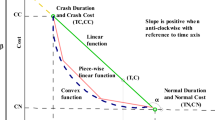Abstract
In conventional project scheduling problem like PERT/CPM, the activity times are determined by experts as crisp numbers. But in an uncertain environment, the representation of an expert may be imprecise. Several factors can affect the schedule. In this paper, a method of solving an interval PERT/CPM problem has been proposed. We have considered interval numbers to represent the activity times which is more realistic in nature. This method is based on interval analysis and provides all the parameters involved in the traditional PERT/CPM technique including interval latest starting and finishing times in the network. It involves a tabular method that is very simple and easy to understand, both for technical and non-technical persons. As the data of the problem are interval numbers, the results are also in terms of interval numbers. Interval total completion time and the critical path can be found by this method even without finding the total float or free float of the activities. A notion of the criticality degree of the activities has been introduced here. A numerical example illustrates the method.

Similar content being viewed by others
References
Sengupta, A., Pal, T.K.: Theory and methodology on comparing interval numbers. Eur. J. Oper. Res. 127, 28–43 (2000)
A. Sengupta, T.K. Pal, A-index for ordering interval numbers, Presented in Indian Science Congress 1997, Delhi University, (1997)
Saha, A., Pal, M., Pal, T.K.: Selection of programme slots of television channels for giving advertisement: A graph theoretic approach. Inform. Sci. 177, 2480–2492 (2007)
Azaron, A., Perkgoz, C., Sakawa, M.: A genetic algorithm approach for the time-cost trade-o. in PERT networks. Appl. Math. Comput. 168, 1317–1339 (2005)
Amir, A., Reza, T.-M.: A multi-objective resource allocation problem in dynamic PERT networks. Appl. Math. Comput. 181, 163–174 (2006)
Chanas, S., Dubois, D., Zieliński, P.: On the sure criticality of tasks in activity networks with imprecise durations. IEEE Trans. Syst. Man Cybern. B Cybern. 32, 393–407 (2002)
Chanas, S., Kamburowski, J.: The use of fuzzy variables in PERT. Fuzzy Set Syst. 5, 11–19 (1981)
Chanas, S., Delgado, M., Verdgay, J.L., Vila, M.A.: Ranking fuzzy interval numbers in the setting of random sets. Inform. Sci. 69(3), 201–217 (1993)
Chanas, S., Zielinski, P.: Critical path analysis in the network with fuzzy task times. Fuzzy Set Syst. 122, 195–204 (2001)
Chanas, S., Zieliński, P.: The computational complexity of the criticality problems in a network with interval activity times. Eur. J. Oper. Res. 136, 541–550 (2002)
Chanas, S., Zielinski, P.: On the hardness of evaluating criticality of activities in a planar network with duration intervals. Oper. Res. Lett. 31, 53–59 (2003)
Chanas, S., Zielinski, P.: Ranking fuzzy interval numbers in the setting of random sets-further results. Inform. Sci. 117(3), 191–200 (1999)
Chau, D., Chan, W., Govindan, K.: A time–cost trade-off model with resource consideration using genetic algorithm. Civ. Eng. Syst. 14, 291–311 (1997)
Chen, S.M., Chang, T.H.: Finding multiple possible critical paths using fuzzy PERT. IEEE Trans. Syst. Man Cybern. B Cybern. 31, 930–937 (2001)
Chen, C.-T., Huang, S.-F.: Applying fuzzy method for measuring criticality in project network. Inform. Sci. 177, 2448–2458 (2007)
Dubois, D., Fargier, H., Galvagonon, V.: On latest starting times and floats in task networks with ill-known durations. Eur. J. Oper. Res. 147, 266–280 (2003)
Dubois, D., Prade, H.: Ranking fuzzy numbers in the setting of possibility theory. Inform. Sci. 30, 183–224 (1983)
Giovanni, M.: Measuring uncertainty and criticality in network planning by PERT-path technique. Int. J. Proj. Manag. 15, 377–387 (1997)
Ishibuchi, H., Tanaka, H.: Multiobjective programming in optimization of the interval objective function. Eur. J. Oper. Res. 48, 219–225 (1990)
Jha, K.N., Iyer, K.C.: Critical determinants of project coordination. Int. J. Proj. Manag. 24, 314–322 (2006)
Kamburowski, J.: An upper bound on the expected completion time of PERT networks. Eur. J. Oper. Res. 21, 206–212 (1985)
Kaufmann, A., Gupta, M.M.: Introduction to Fuzzy Arithmetic: Theory and Applications. International Thomson Computer Press, London (1991)
Ganesan, K., Veeramani, P.: On arithmetic operations of interval numbers. Int. J. Uncertainty, Fuzzyness Knowl Based Syst 13(6), 619–631 (2005)
Partovi, F.Y., Burton, J.: “Timing of monitoring and control of CPM projects,”. IEEE Trans. Eng. Manage. 40, 69–75 (1993)
Moore, R.E.: Method and Application of Interval Analysis. SIAM, Philadelphia (1979)
Robillard, P., Trahan, M.: The completion time of PERT networks. Oper. Res. 25, 15–29 (1977)
Roy, G., Nava, P., Israel, S.: Integrating system analysis and project management tools. Int. J. Proj. Manag. 20, 461–468 (2002)
Sculli, D.: The completion time of PERT networks. J. Oper. Res. Soc. 34, 155–158 (1983)
Chen, S.-P.: Analysis of critical paths in a project network with fuzzy activity times. Eur. J. Oper. Res. 183, 442–459 (2007)
Slyeptsov, A.I., Tyshchuk, T.A.: Fuzzy temporal characteristics of operations for project management on the network models basis. Eur. J. Oper. Res. 147, 253–265 (2003)
Tersene, R.J.: Production Operations Management: Concepts, Structure, and Analysis. North-Holland, The Netherlands (1983)
Wang, W.C.: Impact of soft logic on the probabilistic duration of construction projects. Int. J. Proj. Manag. 23, 600–610 (2005)
Zadeh, L.A.: Fuzzy sets. Inf. Control. 8, 338–353 (1965)
Zadeh, L.A.: Toward a generalized theory of uncertainty (GTU) – an outline. Inform. Sci. 17, 1–40 (2005)
Zhu, Z., Heady, R.B.: A simplified method of evaluating PERT/CPM network parameters. IEEE Trans. Eng. Manag. 41(4) (1994)
Zieliński, P.: On computing the latest starting times and floats of activities in a network with imprecise durations. Fuzzy Set Syst. 150, 53–76 (2005)
Zimmerman, H.J.: Fuzzy Set Theory and Its Applications, 2nd edn. Kluwer Academic Publishers, Boston (1991)
Author information
Authors and Affiliations
Corresponding author
Rights and permissions
About this article
Cite this article
Mukherjee, S., Basu, K. Solution of interval PERT/CPM network problems by a simplified tabular method. OPSEARCH 48, 355–370 (2011). https://doi.org/10.1007/s12597-011-0056-z
Accepted:
Published:
Issue Date:
DOI: https://doi.org/10.1007/s12597-011-0056-z




